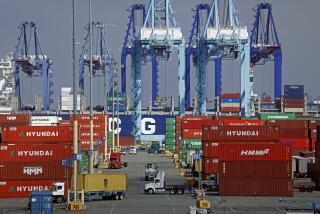West Needs New Economic Foundations
- Share via
A little beyond the halfway point in the decade, the economy of the American West is at a crossroads.
Buffeted by structural economic and demographic changes, the Western states are faced simultaneously with the challenges of creating new jobs and sources of income and financing a social, economic and governmental infrastructure capable of promoting long-term economic development.
Compared to the national averages, virtually every Western state’s economy is overrepresented in agriculture, forestry and mineral extraction, and significantly underrepresented in manufacturing. Much of the region’s manufacturing is also directly or indirectly linked to commodities production through the manufacturing of agricultural and mining equipment, or processing. Similarly, the Western region displays a disproportionate reliance on federal money: Nine of 16 Western states receive total per-capita federal outlays at a level equal to or above the national average. In terms of federal per-capita outlays for salaries and wages, 12 Western states record levels significantly above the national average--a reflection of the substantial direct military presence in the region.
Thus the economy of the West rests largely on two legs: natural resources and defense. But in an economic climate marked by falling commodity prices and disinflation, and a political climate characterized by the New Federalism, Gramm-Rudman and an emerging consensus for reduced defense expenditures, Western states will increasingly experience economic difficulty.
Some evidence of incipient decline is emerging already: All of the Western states except Arizona and California are characterized by a dramatic slow-down in population growth rates that are well below the national average. Wyoming’s population actually declined by 0.8% between 1984 and 1985.
More disturbing is the evidence of slower-growing or declining relative per-capita income in the Western states: Many exhibit marked relative declines against the national average, in sharp contrast to the 1970s and early ‘80s, when rapid income growth was the norm. This raises a critical question for the region’s policy-makers: In the absence of externally stimulated economic growth, what kinds of policy “tools” can or should be used to encourage long-term economic development? Alternatively, and more pointedly, in a climate of declining prosperity how will the Western states finance the creation of an infrastructure (broadly defined) that encourages new business development and growth of jobs?
Nurturing economic growth in the future will require strategies that are focused internally, not externally. In particular, emphasis should be placed on business retention, job creation through the expansion of existing firms and the encouragement of new business formation. A realistic program for business retention and expansion should also be based on a careful analysis of each community’s comparative advantages and disadvantages, since economic attributes vary widely across the Western region.
In pursuing new business opportunities, the Western states must beware the false promise of high technology. Though high tech is often touted as the road to economic salvation, recent developments would seem to belie this notion. Since 1980, high-tech employment has grown by less than 1% annually--certainly not enough to compensate for the huge job losses in the West’s traditional industries. Furthermore, the high-tech sector appears to be just as cyclical and unstable as mining and traditional manufacturing, as revealed by the recent spate of layoffs, plant closings and bankruptcies in the Silicon Valley and elsewhere.
Decisions made in places like Riyadh and Washington will continue to affect economic outcomes in the West, and the options available to state and local governments to help break these dependencies are limited in the short run. But there are several initiatives that the Western states, either individually or collectively, could pursue to foster a climate that encourages economic diversification and business development. These include restructuring state/local tax systems, deregulating intrastate commerce, encouraging capital formation through revision of state banking laws, and improving the scope and quality of elementary and secondary education.
Because much of the West is in the throes of a profound and permanent reorientation, the next several years will be characterized by additional disruptions and dislocations. But this transitional period is also the optimal time to be thinking strategically about building the foundations for a long-term economic prosperity in the West.
More to Read
Get the L.A. Times Politics newsletter
Deeply reported insights into legislation, politics and policy from Sacramento, Washington and beyond. In your inbox three times per week.
You may occasionally receive promotional content from the Los Angeles Times.










